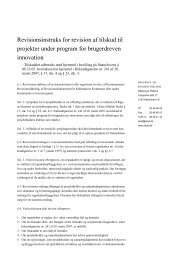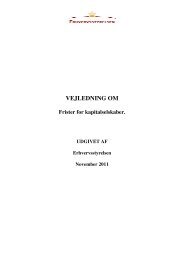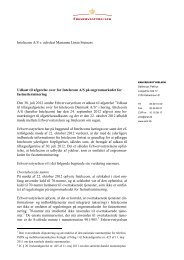Risk-Based Approach â Guidance for Money Service Businesses
Risk-Based Approach â Guidance for Money Service Businesses
Risk-Based Approach â Guidance for Money Service Businesses
Create successful ePaper yourself
Turn your PDF publications into a flip-book with our unique Google optimized e-Paper software.
<strong>Risk</strong>-<strong>Based</strong> <strong>Approach</strong> – <strong>Guidance</strong> <strong>for</strong> <strong>Money</strong> <strong>Service</strong> <strong>Businesses</strong> - July 2009 26. The risk-based approach is challenging to both public and private sector entities. Such anapproach requires resources and expertise to gather and interpret in<strong>for</strong>mation on risks, both at the countryand institutional levels, to develop procedures and systems and to train personnel. It further requires thatsound and well-trained judgment be exercised in the implementation within the institution and itssubcomponents of such procedures and systems. It will certainly lead to a greater diversity in practicewhich should lead to innovations and improved compliance. However, it may also cause uncertaintyregarding expectations, difficulty in applying uni<strong>for</strong>m regulatory treatment, and lack of understanding bycustomers regarding in<strong>for</strong>mation required to per<strong>for</strong>m a transaction.27. Implementing a risk-based approach requires that MSBs have a good understanding of the risksand are able to exercise sound judgment. This requires the building of expertise within MSBs, including<strong>for</strong> example, through training, recruitment, taking professional advice and 'learning by doing'. The processwill always benefit from in<strong>for</strong>mation sharing by competent authorities. The provision of good practiceguidance is also valuable. Attempting to pursue a risk-based approach without sufficient expertise maylead to MSBs making flawed judgments. <strong>Businesses</strong> may over-estimate risk, which could lead to wastefuluse of resources, or they may under-estimate risk, thereby creating vulnerabilities.28. MSBs may find that some staff members are uncom<strong>for</strong>table making risk-based judgments. Thismay lead to overly cautious decisions, or disproportionate time spent documenting the rationale behind adecision. This may also be true at various levels of management. However, in situations wheremanagement fails to recognize or underestimates the risks, a culture may develop within the business thatallows <strong>for</strong> inadequate resources to be devoted to compliance leading to potentially significant compliancefailures. Supervisors should place greater emphasis on whether the MSBs have an effective decisionmakingprocess. However, sample testing should be used or individual decisions reviewed as a means totest the effectiveness of the business‟s overall risk management (see paragraph 88). Supervisors shouldappreciate that even though the MSB has established appropriate risk management structures andprocedures that are regularly updated, and has followed the relevant policies, procedures, and processes,the MSB may still make decisions that were incorrect in light of additional in<strong>for</strong>mation not reasonablyavailable at the time.29. In implementing the risk-based approach MSBs should be given the opportunity to makereasonable judgments. This will mean that no two businesses are likely to adopt the exact same detailedpractices. Such potential diversity of practice will require that regulators make greater ef<strong>for</strong>t to identify anddisseminate guidelines on sound practice, and may pose challenges to supervisory staff working to monitorcompliance. The existence of good practice guidance, supervisory training, industry studies and otheravailable in<strong>for</strong>mation and materials will assist supervisors in determining whether a MSB has made soundrisk-based judgments.The potential benefits and potential challenges can be summarised as follows:Potential Benefits:Better management of risks and cost-benefits.<strong>Money</strong> service business focuses on real and identified threats.Flexibility to adapt to risks that change over time.Potential Challenges:Identifying appropriate in<strong>for</strong>mation to conduct a sound risk analysis.Addressing short term transitional costs.Greater need <strong>for</strong> more expert staff capable of making sound judgments.Regulatory response to potential diversity of practice.© 2009 FATF/OECD - 9
















